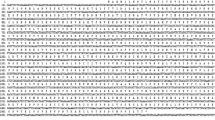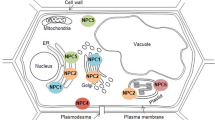Abstract
Phospholipase D (PLD, EC 3.1.4.4) is a key enzyme involved in phospholipid catabolism, initiating a lipolytic cascade in membrane deterioration during senescence and stress, which was cloned from Jatropha curcas L., an important plant species as its seed is the raw material for biodiesels. The cDNA was 2,886 bp in length with a complete open reading frame of 2,427 bp which encoded a polypeptide of 808 amino acids including a putative signal peptide of 53 amino acid residues and a mature protein of 755 amino acids with a predicted molecular mass of 86 kD and a pI of 5.44, having two highly conserved ‘HKD’ motifs. Phylogenetic analysis indicated the J. curcas PLD alpha (JcPLDα) showed a high similarity to other PLD alpha from plants. Semi-quantitative RT-PCR analysis revealed that it was especially abundant in root, stem, leaf, endosperm and flower, weakly in seed. And the JcPLDα was increasedly expressed in leaf undergoing environmental stress such as salt (300 mM NaCl), drought (30% PEG), cold (4°C) and heat (50°C). The JcPLDα protein was successfully expressed in Escherichia coli and showed high enzymatic activities. Maximal activity was at pH 8 and 60°C.






Similar content being viewed by others
References
Exton JH (1997) New developments in phospholipase D. J Biol Chem 272:15579–15582
Exton JH (2002) Regulation of phospholipase D. FEBS Lett 531:58–61
Saito M, Bourque E, Kanfer J (1974) Phosphatidohydrolase and base-exchange activity of commercial phospholipase D. Arch Biochem Biophys 164:420–428
Exton JH (1997) D phospholipase, enzymology, mechanisms of regulation and function. Physiol Rev 77:303–320
Galliard T (1980) Degradation of acyl lipids: hydrolytic and oxidative enzymes. The biochemistry of plants. Academic Press, New York, pp 85–116
Dawidowicz EA (1987) Dynamics of membrane lipid metabolism and turnover. Ann Rev Biochem 56:43–61
McDermott M, Wakelam MJ, Morris AJ (2004) Phospholipase D. Biochem Cell Biol 82:225–253
Meijer HJG, Munnik T (2003) Phospholipid-based signaling in plants. Annu Rev Plant Physiol Plant Mol Biol 54:265–306
Munnik T (2001) Phosphatidic acid: an emerging plant lipid second messenger. Trends Plant Sci 6:227–233
Deschene A, Paliyath G, Lougheed EC, Dumbroff EB, Thompson JE (1991) Membrane deterioration during postharvest storage of broccoli florets: modulation by temperature and controlled atmosphere storage. Postharvest Biol Technol 1:19–31
Paliyath G, Thompson JE (1987) Calcium, calmodulin regulated breakdown of phospholipid by microsomal membranes from bean cotyledons. Plant Physiol 83:63–68
Brown FD, Thompson N, Saqib KM, Clark JM, Powner D, Thompson NT, Solari R, Wakelam MJ (1998) Phospholipase D localises to secretory granules and lysosomes and is plasma-membrane translocated on cellular stimulation. Curr Biol 8:835–838
Borochov A, Cho MH, Boss WF (1994) Plasma membrane lipid metabolism of petunia petals during senescence. Physiol Plant 90:279–284
Exton JH (1994) Phosphatidylcholine breakdown and signal transduction. Biochim Biophys Acta 1212:26–42
Gustavsson L, Moehren G, Torress-Marquez ME, Benistant C, Rubin R, Hoek JH (1994) The role of cytosolic Ga 2+ , protein kinase C, and protein kinase A in hormonal stimulation of phospholipase D in rat hepatocytes. J Biol Chem 269:849–859
Dalziel JM (1955) The useful plants of west-tropical Africa. Crown agents for oversea governments and administration, London, p 147
Muanza DN, Euler KL, Williams L, Newman DJ (1995) Screening of antitumor and anti-HIV activities of nine medicinal plants from Zaire. Int J Pharmacogn 33:98–106
Saneoka H, Ishiguro S, Moghaieb REA (2001) Effect of salinity and abscisic acid on accumulation of glycinebetaine and betaine aldehyde dehydrogenase mRNA in Sorghum leaves (Sorghum bicolor). J Plant Physiol 158:853–859
Sambrook J, Russell DW (2001) Molecular cloning: a laboratory manual, 3rd edn. Cold Spring Harbor, New York
Imamura S, Horiuti Y (1978) Enzymatic determination of phospholipase D activity with choline oxidase. J Biochem 83:677–680
Ponting CP, Kerr ID (1996) A novel family of phospholipase D homologues that include phospholipid synthases, putative endonucleases. Protein Sci 5:914–922
Ryu SB, Wang X (1995) Expression of phospholipase D during castor bean leaf senescence. Plant Physiol 108:713–719
Liscovitch M, Czarny M, Fiucci G, Tang X (2000) Phospholipase D: molecular and cell biology of a novel gene family. Biochem J 345:401–415
Gottlin EB, Rudolph AE, Zhao Y, Matthews HR, Dixon JE (1998) Catalytic mechanism of the phospholipase D superfamily proceeds via a covalent phosphohistidine intermediate. Proc Natl Acad Sci USA 95:9202–9207
Pinhero RG, Almquist KC, Novotna Z, Paliyath G (2003) Developmental regulation of phospholipase D in tomato fruits. Plant Physiol Biochem 41:223–240
Verslues PE, Zhu JK (2005) Before and beyond ABA: upstream sensing and internal signals that determine ABA accumulation and response under abiotic stress. Biochem Soc Trans 33:375–379
Mahajan S, Tuteja N (2005) Cold, salinity and drought stresses: an overview. Arch Biochem Biophys 444:139–158
Ritchie S, Gilroy S (1998) Abscisic acid signal transduction in the barley aleurone is mediated by phospholipase D activity. Proc Natl Acad Sci USA 95:2697–2702
Munnik T, Musgrave A (2001) Phospholipid signaling in plants: holding on to phospholipase D. Science PE42
Yuan HY, Chen LG (2005) Characterization of microsomal and mitochondrial phospholipase D activities and cloning of a phospholipase D alpha cDNA from strawberry fruits. Plant Physiol Biochem 43:535–547
Simkhada JR, Lee HJ (2009) A novel alkalo- and thermostable phospholipase D from Streptomyces olivochromogenes. Biotechnol Lett 31:429–435
Acknowledgments
We thank the reviewers for useful suggestions. This research is supported by grants from “11th Five-Year Plan” to support science and technology project (no. 2007BAD50B05) and Ministry of education key program (no. 307023).
Author information
Authors and Affiliations
Corresponding author
Rights and permissions
About this article
Cite this article
Liu, B., Yao, L., Wang, W. et al. Molecular cloning and characterization of phospholipase D from Jatropha curcas . Mol Biol Rep 37, 939–946 (2010). https://doi.org/10.1007/s11033-009-9727-8
Received:
Accepted:
Published:
Issue Date:
DOI: https://doi.org/10.1007/s11033-009-9727-8




